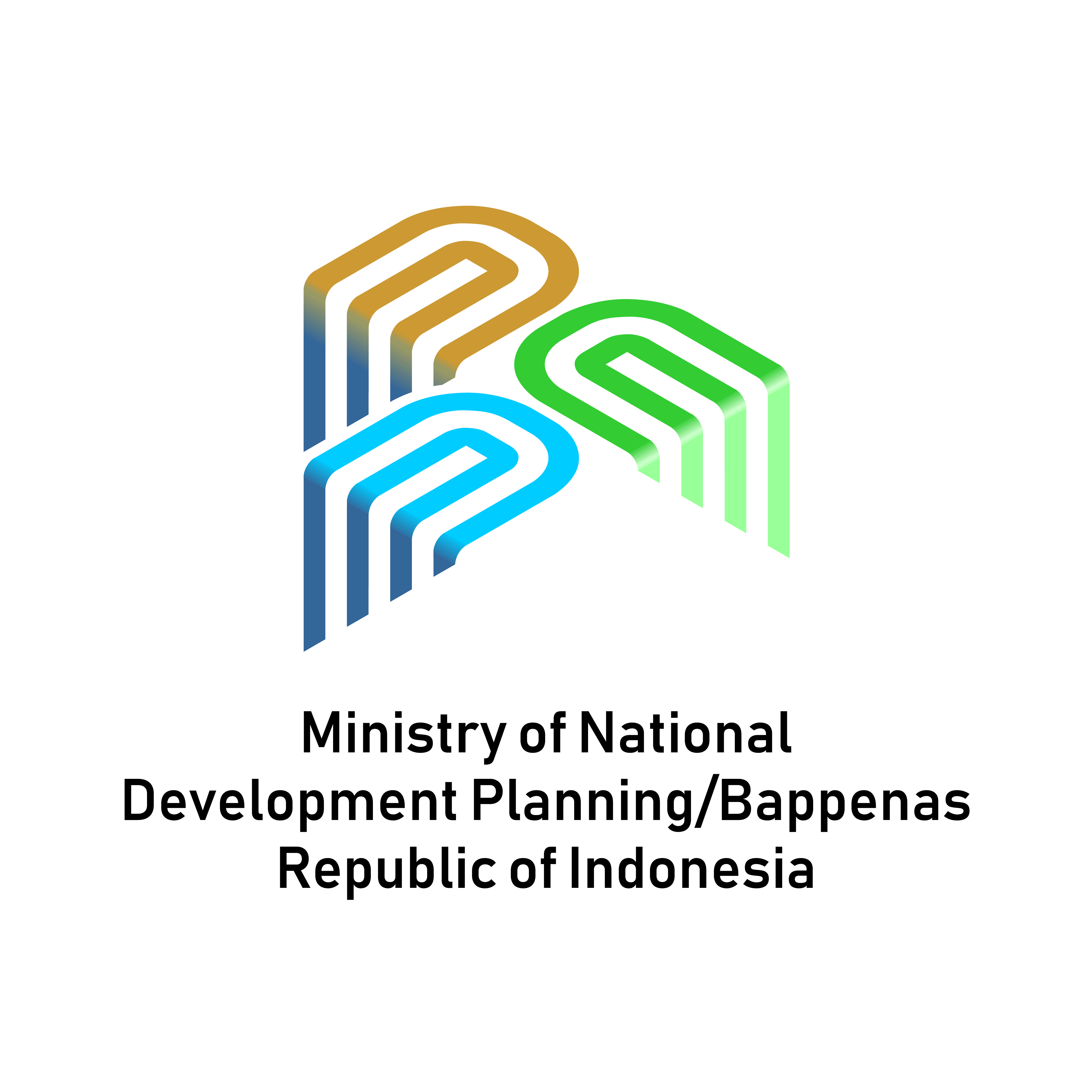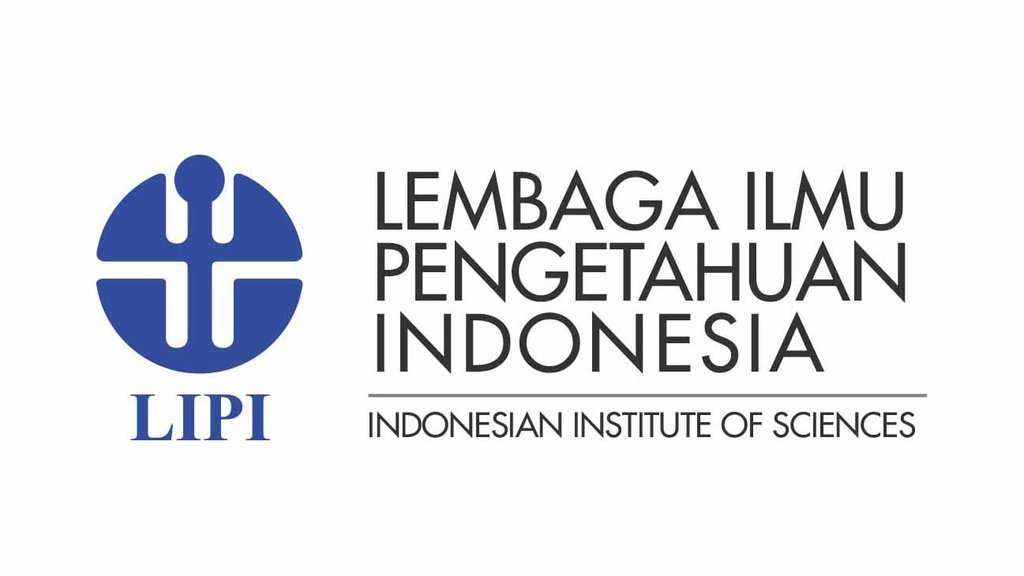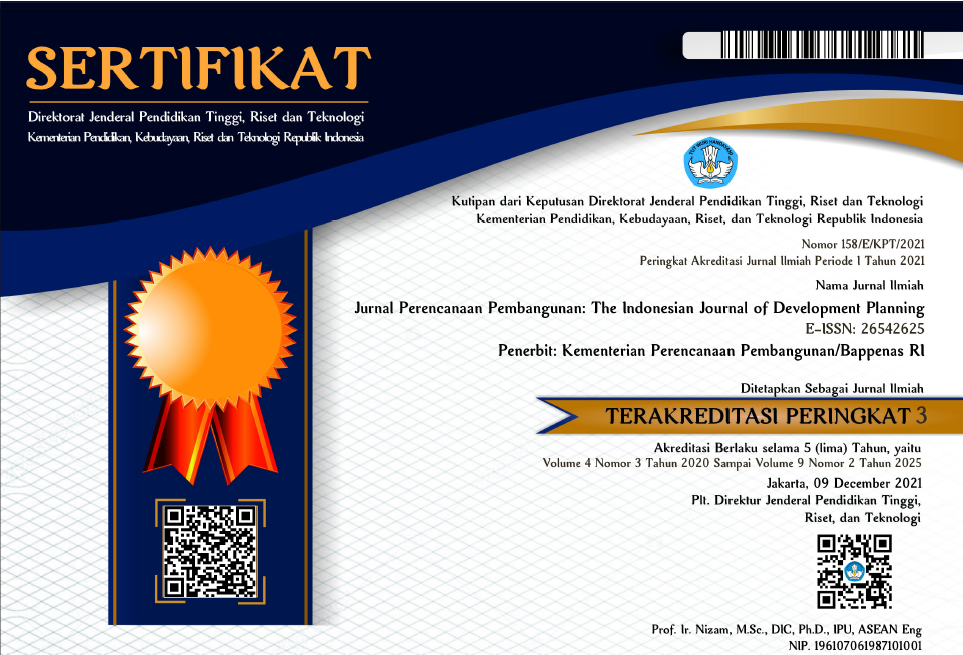Government Health Expenditure and Stunting Prevalence Reduction in Indonesia
DOI:
https://doi.org/10.36574/jpp.v7i2.452Keywords:
government health expenditure, regional government, stunting prevalence, panel data analysisAbstract
Indonesia has started to set policies and programs to alleviate stunting prevalence in the last decade. By reducing stunting prevalence, the government has cut the short-term and long-term effects of stunting. Government health expenditure at the regional level is also part of regional government expenditure, which is proposed to overcome health issues. This research empirically examines the correlation between government health expenditure and stunting prevalence reduction in Indonesia. The data on government health expenditure is obtained from the Ministry of Finance, and the data on stunting prevalence is compiled from several sources such as Riskesdas (Ministry of Health), SSGBI (Ministry of Health), and Statistics of Indonesia (BPS). The panel data uses the provincial level of data from 2010 until 2020, covering 33 provinces, and is estimated with the Fixed Effects (FE) model and the robustness check of the heteroskedasticity problem using fixed robustness. The results show that government health expenditure significantly reduces the prevalence of stunting in all provinces and provinces located outside Java Island.
Downloads
References
Alcazar, L, Ocampo, D, Huaman-Espino, L & Pablo, J, (2012). ‘Economic impact of chronic, acute and global malnutrition in Peru’, Rev Peru Med Exp Salud Publica, vol. 30, pp. 569–74
Allison, P. (2019). ‘Asymmetric Fixed-effects Models for Panel Data’, Socius, DOI:10.1177/2378023119826441
Arestis, P, Sen, H, & Kaya, (2020). ‘On the Linkage between Government Expenditure and Output: Empirics of the Keynesian View Versus Wagner's Law’. Economic Change and Restructuring, vol. 54, pp. 265-303
Baltagi, B. (2013). ‘Econometric Analysis of Panel Data’, Wiley, Chichester, 5th ed
Bagriansky, J, Champa, N, Pak, K, Whitney, S & Laillou A (2014). ‘The economic consequences of malnutrition in Cambodia are more than 400 million dollars lost annually’, Asia Pac J Clin
Barker, D. (2007). ‘The origins of the developmental origin theory, Journal of Internal Medicine, vol. 261, pp. 412–417, DOI:10.1111/j.1365-2796
Bhalotra, S (2002). ‘Welfare implications of fiscal reform: The case of food subsidies in India’, Discussion Paper, vol. 32, World Institute for Economics Research, Helsinki
Black RE, Victora, CG, Walker, SP, Bhutta, ZA, Christian, P & de Onis, M (2013). ‘Maternal and child undernutrition and overweight in low-income and middle-income countries. Lancet, vol. 382, pp. 427–451
Black, RE, Morris, SS & Bryce, J (2003). ‘Where and why are 10 million children dying every year’. Lancet, vol. 361, pp. 2226–2234
Bowser, D, Zeng, W, Akobirshoev, I, Morrill, T & Nandakumar (2016). ‘The impact of health care spending and income inequality on stunting prevalence’, International Journal of Healthcare. 2nd edn, DOI: 10.5430/ijh.v2n2p23
Brown, R, Natali, S, Jeremy, S & Carmel, D (2020). ‘Multi-sectoral Nutrition Programming: A review of current literature and evidence’, www.ennonline.net/mspliterature2020
Dartanto, T, & Brodjonegoro, B 2003, ‘Dampak Desentralisasi Fiskal di Indonesia terhadap Pertumbuhan Ekonomi dan Disparitas Antar Daerah: Analisis Model Makro dan Ekonometrik Simultan’, Indonesian Journal of Economics and Development, vol. 4, pp. 1
Edame, GE & Eturoma, AD (2014). ‘The Determinants of Public Expenditure on Educational Infrastructural Facilities and Economic Growth in Nigeria’ Journal of Business Management and Economics, vol. 5, pp. 152-161
Figueroa-Lara & A Martinez, VA (2013). ‘Addressing social determinants of health through intersectoral actions: five public policy cases from Mexico’, WHO, Geneva, ISBN: 9789241505314
Fox, J (2016). ‘Applied Regression Analysis and Generalized Linear Models. Los Angeles’, vol. 23, pp. 524, Sage Publications, CA
Friedman, J, et al. (2006). ‘Health Sector Decentralization and Indonesia’s Nutrition Programs: Opportunities and Challenges (English)’, World Bank, Washington, DC, http://documents.worldbank.org/curated/en/101241468049450209/Health-sector-decentralization-and-Indonesiasnutrition-programs-opportunities-and-challenges
Garrett, J & Natalicchio (2011). ‘Working multi-sectoral in nutrition: Principles, practices, and case studies, IFPRI Research Monograph, International Food Policy Research Institute (IFPRI) Washington, D.C., http://dx.doi.org/10.2499/9780896291812
Giannoni, M & Hitiris, T (2002). ‘The Regional Impact of Health Care Expenditure: The Case of Italy’, Applied Economics Letters, vol. 14
Global Nutrition Report (2016). https://globalnutritionreport.org/reports/2016-global-nutrition-report/
Gupta, S, Clements, B, & Inchauste, G (2004). ‘Helping Countries Develop: The Role of Fiscal Policy, International Monetary Fund, Washington DC
Hoddinott, J, Harold, A, Jere, B, Lawrence, H & Susan, H (2013). ‘The Economic Rationale for Investing in Stunting Reduction’, Grand Challenges Canada Economic Returns to Mitigating Early Life Risks Project Working Paper Series, 8th edn
Hossain, M, Choudhury, N, Adi, BAK, Mondal, P, Jackson, AA, Walson J & Ahmed, T (2016). ‘Evidence-based approaches to childhood stunting in low and middle-income countries: a systematic review’, Arch Dis Child, vol. 102(10), pp. 903–909, DOI: 10.1136/archdischild-2016-311050
Howitt, P (2005). ‘Health, Human Capital and Economic Growth: A Schumpeterian Perspective. In Health and Economic Growth: Findings and Policy Implications’ G. Lopez-Casasnovas, B. Rivera, and L. Currais’, eds. Cambridge, MA, MIT Press.
Indonesian Nutrition Studies Status (SSGI) 2021, https://www.litbang.kemkes.go.id/buku-saku-hasil-studi-status-gizi-indonesia-ssgi-tahun-2021/
Indra, J, Khoirunurrofik, K (2022). ‘Understanding the role of village fund and administrative capacity in stunting reduction: Empirical evidence from Indonesia’, PLoS ONE, vol. 17(1): e0262743, DOI: 10.1371/journal.pone.0262743
Indrastuty, D & Pujiyanto 2019, ‘Determinan Sosial Ekonomi Rumah Tangga dari Balita Stunting di Indonesia: Analisis Data Indonesia Family Life Survey (IFLS) 2014’, Jurnal Ekonomi Kesehatan Indonesia, vol. 3, DOI: 10.7454/eki.v3i2.3004
Jonsson U 2010, ‘The rise and fall of paradigms in world food and nutrition policy, World Nutrition June, vol 1 & 3, pp. 128-158
Wooldridge, JM 2010, ‘Econometric Analysis of Cross Section and Panel Data,’ MIT Press Books, The MIT Press, 2nd ed, vol. 1, no. 0262232588
Maitra, B & Mukhopadhyay, CK 2012, ‘Public Spending on Education, Health Care and Economic Growth in Selected Countries of Asia and The Pacific, Asia-Pacific Development Journal, vol. 19
Martorell, R 1999, ‘The nature of child malnutrition and its long-term implications’, Food and Nutrition Bulletin, vol. 20(3), pp. 288–292
McCoy, D, Peet, E & Ezzati, M 2016, ‘Early childhood development status in low and middle?income countries: National, regional and global prevalence estimates using predictive modeling’, PloSMed, 13, e1002034
McGovern, ME, Aditi, K, Victor, MA & Subramanian, SV 2017, ‘A review of the evidence linking child stunting to economic outcomes’, International Journal of Epidemiology, vol. 46, Issue 4, pp. 1171–1191, DOI:10.1093/ije/dyx017
Ministry of Health 2018, Profil kesehatan Indonesia 2018 (Indonesia Health Profile 2018), Ministry of Health of the Republic of Indonesia, Jakarta
Nasution, M 2022, ‘Studi atas belanja Kesehatan pemerintah daerah di Indonesia 6’, Journal budget, vol. 7, 1st edn, Pusat Kajian Anggaran, Jakarta
National Basic Health Research (RISKESDAS) 2010, https://labdata.litbang.kemkes.go.id/riset-badan-litbangkes/menu-riskesnas/menu-riskesdas/148-rkd-2010
National Basic Health Research (RISKESDAS). 2018 https://kesmas.kemkes.go.id/assets/upload/dir_519d41d8cd98f00/files/Hasil-riskesdas-2018_1274.pdf
National Plan of Action for Food and Nutrition (NPA-FN) 2011 https://extranet.who.int/nutrition/gina/sites/default/filesstore/IDN%202011%20Rencana%20Aksi%20Nasional%20Pangan%20dan%20Gizi.pdf2018.
National Plan of Action for Food and Nutrition (NPA-FN) 2017, https://stunting.go.id/?smd_process_download=1&download_id=7943
Nutrition Programming: A review of current literature and evidence 2020, www.ennonline.net/mspliterature2020
Onis, M & Branca, M 2016, ‘Childhood stunting: a global perspective’, Maternal & Child Nutrition, vol. 12, pp. 12-26
Paramita, A, Izza, N, T, & Laksono, Agung 2022, ‘Does the Proximity of the Area Affect in Incidence of Stunting?: Study on Densely Populated Provinces in Indonesia. Indian Journal of Forensic Medicine and Toxicology, vol. 16, pp. 131-140, DOI:10.37506/ijfmt.v16i3.18257
Peacock, AT & Wiseman, J 1967, ‘The Growth of Public Expenditure in The United Kingdom: Allen and Unwin’
Pischke, JS & Joshua DA 2009, "Mostly Harmless Econometrics: An Empiricist's Companion," Economics Books, Princeton University Press, 1st ed, no. 8769
Scaling Up Nutrition (SUN) 2015, ‘Nutrition and the Sustainable Development Goals. Scaling Up Nutrition, https://scalingupnutrition.org/nutrition/nutrition-and-the-sustainable-development-goals/
Tempo Media, https://nasional.tempo.co/read/1524875/ragam-layanan-gratis-jaminan-kesehatan-untuk-warga-dki-jakarta
Titaley, CR, Ariawan, I, Hapsari, D, Muasyaroh, A, & Dibley, MJ, 2019, ‘Determinants of the Stunting of Children Under Two Years Old in Indonesia: A Multilevel Analysis of the 2013 Indonesia Basic Health Survey’, Nutrients, vol. 11(5), DOI:10.3390/nu11051106
TNP2K, see Tim Nasional Percepatan Penangulangan Kemiskinan (National Team for the Acceleration of Poverty Reduction)
Treiman, D 2009, ‘Quantitative Data Analysis: Doing Social Research to Test Ideas’, Jossey-Bass, San Francisco, CA
United Nations (UN), 2014, ‘The Millenium Development Goals Report 2014’, United Nations Press, New York, ISBN 978-92-1-101308-5
UNICEF 1990, ‘A UNICEF Policy Review: Strategy for Improved Nutrition of Children and Women in Developing Countries’, UNICEF, New York
Vilcins, D, Sly, PD, & Jagals, P 2018 ‘Environmental Risk Factors Associated with Child Stunting: A Systematic Review of the Literature Annals of global health, vol. 84(4), pp. 551–562. DOI:10.9204/aogh.2361
World Health Organization 2010, ‘A conceptual framework for action on the social determinants of health, World Health Organization
World Health Organization (WHO) 2016, ‘A conceptual framework for action on the social determinants of health’ World Health Organization.
World Health Organization (WHO), ‘Overview of Malnutrition’, https://www.who.int/health-topics/malnutrition#tab=tab_1
Yusri, A (2022). ‘Does Government Expenditure Affect Poverty, Health, and Education? Evidence from Aceh, Indonesia Jurnal Perencanaan Pembangunan: The Indonesian Journal of Development Planning’, vol. 6, pp. 1–20, DOI:10.36574/jpp.v6i1.249
Downloads
Published
Versions
- 2023-09-01 (2)
- 2023-08-31 (1)
How to Cite
Issue
Section
License
Copyright (c) 2023 Jurnal Perencanaan Pembangunan: The Indonesian Journal of Development Planning

This work is licensed under a Creative Commons Attribution-NonCommercial-ShareAlike 4.0 International License.
This is an open-access article distributed under the terms of the Creative Commons Attribution-NonCommercial-ShareAlike 4.0 International License. Copyright © Kementerian PPN/Bappenas RI


















